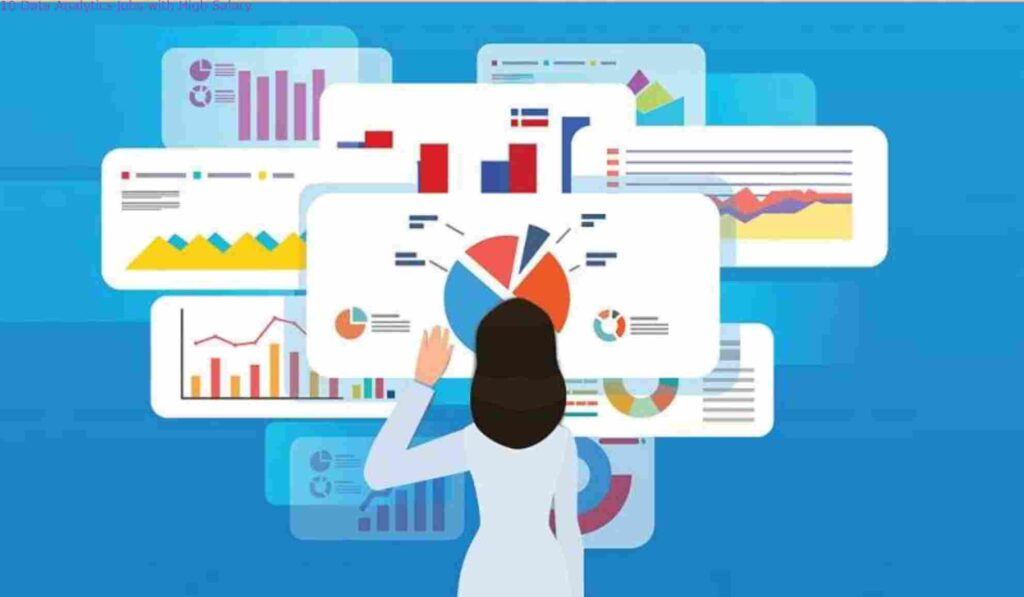10 Data Analyst Jobs with High Salary

10 Data Analytics Jobs with High Salary
The time is now to follow your ambition of becoming a data analyst if you have always wanted to do that. The era of big data is currently in its prime. We will witness even more fascinating developments in data science in 2020 and 2021, including autonomous machine learning systems (AutoML), DevOps and DataOps engineering, virtual and augmented reality (VR/AR), and the synergistic effects of fusing these and other technologies. You will undoubtedly need to travel a complicated and drawn-out journey to acquire all the information and abilities required to become a data analyst. You might also need assistance with your homework to earn the grades you want and a distinguished career down the road. Students may save a lot of time and stress by asking for help with their coding and other assignments. The work put forth paid off well in the end.
Many people desire to work as data analysts and earn a respectable income. You should be aware that there are some ambiguities and that we won’t be able to reach this number immediately. There are several sorts of data analysts, so we must first clarify what we mean by this profession before quickly examining them. The pay for each group will be made public later.
Table of Contents
What Is Required to Work in Data Analytics?
Using data to inform decisions is not only an excellent idea. Today’s environment has created new circumstances where a data-driven strategy is crucial for managers and line personnel. These days, failing to analyse company indicators and come to the appropriate conclusions properly frequently verges on being inappropriate.
An analyst analyses and uses that data to provide forecasts, strategies, plans, and customer recommendations.
There are several occupations with the term “analyst” in their names, including financial analysts, programme analysts, system analysts, etc. They all analyse various data types, although not all of them must employ math, statistics, or computer languages in their job. They need to be set apart from the related “data analyst” profession.
A data analyst should know business, economics, computer science, statistics, and mathematics. It is crucial that a person like working with statistical data, creating charts and tables, seeing trends, organising information, emphasising the most significant details, and ignoring the less important ones. Data, numbers, and algorithms are the main categories that the analyst interacts with. You must choose the audience carefully and make as few mistakes as possible while making requests. The analyst must consider all elements that can impact the analysis’s outcome and not overlook any crucial information. If not, he will obtain inaccurate numbers and draw inaccurate inferences from the result.
What Knowledge Must a Data Analyst Have?
A data analyst must be aware of the following:
- system analysis, the ability to formally represent the findings in the field;
- creation of test plans for software;
- employing the top-level programming languages (C++, SAS, R, and Python);
- process formalisation, documentation, and modelling, including unique notations and techniques (ERM, EPC, UML, DFD, ARIS, etc.);
- Use of specific software.
Career
From being a straightforward analyst, you may go to management by creating your products, managing their development, and becoming a team leader.
You may enhance your coding abilities, advance your data analyst skills, progress to larger organisations, choose a more well-liked and prominent path, engage in data modelling and big data, and produce forecasts and predictions. After all, you may always work for yourself or start your own business.
Salaries
According to Glassdoor, the average annual compensation for a data analyst is close to 67,000. Before passing judgement, we need to consider a few things. Your experience and skill level determines the income you will receive. A senior data analyst’s salary might range from 80 to 140 thousand dollars, whereas an entry-level data analyst makes about 35,000 annually.
The geographic location and professional demand are other factors affecting pay. As a result, it would appear that Seattle, the San Francisco Bay Area, and Los Angeles have the finest opportunities for those involved in data analysis.
The industry you choose to work in significantly impacts your compensation. These are the industries with the highest average earnings, per research, and their respective industries:
- Financial Data Analyst ($83,000):
- Clinical Data Analyst ($72,7000);
- Business Data Analyst ($72,500);
- Human Resources Data Analyst ($65,600);
- Data Analyst costing ($65.300).
The quantity of money also depends on the employer’s name. The businesses in the USA that pay their analysts the highest salaries are:
- Facebook ($135,919);
- Microsoft ($113,104);
- Freddie Mac (111.047);
- Intermountain Healthcare ($108,686);
- LinkedIn.($108.196)
Remember that salaries typically rise by at least 15% every year.
Even though you won’t be making millions of dollars in data analysis, this vocation is steadily rising to the top of the list of options. It is a reliable, significant, and tried method to guarantee a successful future profession. Even though an entry-level data Analyst’s compensation might not be very high, it is still a fantastic place to start. If you concentrate on learning and developing your talents, you won’t even realise how rapidly your career will grow (and your pay will rise!). Aside from that, there are several options to change careers.
Also read:-Understanding The Advantages Of Cloud-Managed Wireless Networks




